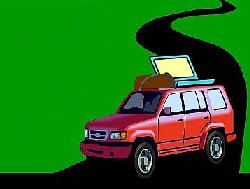Two Public Speaking Models for Marketers – Educating vs. Selling from the Stage
by Marcia Yudkin
You may have heard that speaking – on stage, in teleseminars, via webinars – is a terrific way to build your list and get those in your target market excited about doing business with you. What you probably have not heard is that there are two vastly different paradigms for using speaking to generate leads and grow your customer base.
Depending on your goals and your vision of how you prefer to relate to clients, you’ll surely gravitate to one model or the other. This is important, because mixing elements from the two models leads to frustration and confusion, both on your part and among your audience.
|
Master Information Marketing - From Product Creation to Sales
In seven step-by-step lessons, learn the easiest, most profitable ways to begin packaging and selling what you know. Move from making money only when you're working to enjoying while-you-sleep income.
Discover how to build a marketing funnel
by providing value every time prospects
encounter you. Launch Your Information Empire course details. |
Once you understand your preferences, you’ll know which marketers to emulate and which to ignore – and why. And because you’ll be more consistent in how you speak, you’ll see results from your speaking efforts gradually improving.
Model #1: Speaking to Sell
Here the overall goal is to maximize sales to those in the audience, both now and in the future. Whatever accomplishes that goal is considered appropriate. Any education that comes about through the event is incidental and not a high priority.
Model #2: Speaking to Educate
Here the overall goal is to provide a service to the audience by informing them about a topic area. Those who find this education helpful are invited in a low-key way to become clients, either by simply signing on to a list where they will be further educated and sold to over time, by contacting the speaker after the talk or by making a small introductory purchase now. In this model, selling takes place but it is essential for each educational event to be complete and self-contained rather than a
cannily structured come-on for something else.
|
Use Seminars as a
Lead Generator for a Profitable Next
Year
Make next year your most successful
ever! Following a step-by-step process,
create a plan that builds on business
assets you already have in place, aims
at goals that are both realistic and
designed to make you happy, and
manageably breaks down the imperative of
bringing in more sales. The
Marketing Plan Course includes an abundance
of checklists and strategic pointers as
well as my personal
feedback. Learn
more. |
Advice from proponents of Model #1:
* Speak fast, which creates an environment conducive to buying. It doesn’t matter whether or not the audience can follow.
* Tell your personal story so the audience will feel comfortable buying from you.
* Include testimonials and success stories, which prime people to buy.
* Ignore program evaluations. All that counts is how much you sold from each event.
* Provide an order form, not handouts.
* If using informative slides, keep them up only for a short time. Their function is to serve as teasers for a paid product, not to teach anything.
* Don’t charge a speaking fee. Your compensation is your sales. It’s customary to split event sales 50/50 with the sponsor of the
event, the partner who corralled the listeners.
* End with an explicit offer and tell the audience where to go immediately with their credit card or cash in hand.
|
Run Your Business From the Beach, Shangri-La or Anywhere
Got the urge to hit the
road? Discover tips, tools and strategies for continuing to bring in the moolah while vacationing, traveling, moving to a temporary location or living full-time in an RV.
This course resolves your "but what about..." concerns about taking off.
Be a Digital Nomad. |

Take Your Business on the
Road Course |
|
Advice from proponents of Model #2:
* Master the art of speaking, so listeners have the best possible educational experience when in your audience.
* Have someone else introduce you so you can concentrate on subject matter during your talk. Stay away from personal anecdotes unless they drive home an educational point.
* Include examples to the extent that they make your educational points more vivid.
* Always scrutinize program evaluations for ways you can improve.
* Provide handouts that include your short bio and where audience members can learn more from you.
* When using slides, orchestrate them so participants can absorb the information more easily.
* If an audience includes perfect prospects, you may agree to speak for free, but given the valuable educational information you provide, speaking fees are welcome and appropriate. Sales at or immediately after an event are a nice bonus, not the main goal. Event sponsors do not receive a cut of sales.
* Conclude with a strong close that reinforces the overall theme of your talk and the audience’s perception of you as the expert.
Both of these models can build a large, thriving business. Sticking to the model is important so that those in the audience receive consistent signals and know what to expect from you in the future.
My own passionate preference is for Model #2 because I find it more respectful of audiences and it better fits my values and personality. When I encounter gurus using Model #1, I can’t stand to follow them for long because I come to feel all they care about is money.
In addition, I often feel tricked because a
presentation that was billed as educational
turns out to be a shallow come-on.
Those who master
Model #1 may end up richer, but that's fine with
me. I have my self-respect, an upstanding
reputation and uncommonly
loyal customers. So can you!
Copyright 2011 Marcia Yudkin. All rights reserved.
Learn
more about Marcia's comprehensive information
marketing course.
Discover
how to present a profitable program of
teleseminars.
Browse
the complete index of articles on this site.
|






